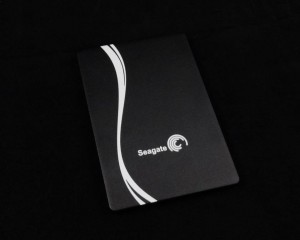 You might remember us breaking the news of Seagates planned entry into the SSD arena at ceBIT in Germany last March. This mornings news of two 2.5″ form factor SSDs, one 12Gb/s SAS, and one PCIe SSD, marks Seagate’s official jump into the SSD arena…and what a jump it is.
You might remember us breaking the news of Seagates planned entry into the SSD arena at ceBIT in Germany last March. This mornings news of two 2.5″ form factor SSDs, one 12Gb/s SAS, and one PCIe SSD, marks Seagate’s official jump into the SSD arena…and what a jump it is.
Even better news is that today we are bringing to you a detailed analysis of Seagates new 600 SSD a notebook form factor SATA 3 SSD that will be the first in 5mm notebook ultra-thin SSDs.
SPECIFICATIONS – ITS ONLY 5MM THICK
The Seagate 600 SSD is a SATA 3 SSD, fully compatible with SATA 2 systems, is available in capacities of 120, 240 and 480GB, and comes with a standard three year warranty. Although available in the thin 7mm height, the 600 will be the first to be available in a 5mm height, offering a new SSD design to ultrabooks that today contain mSATA SSDs for their compact size. Pricing for the consumer retail 600 SSD was not set at the time of this report, however, we have been informed that consumer availability be current with this release. Below is a complete list of specifications and a quick click on any of our pictures will bring up a larger, higher resolution image.
SEAGATE 600 SSD COMPONENTS
Our sample Seagate 600 is a 480GB sample and 7mm in height. The exterior is constructed of a textured black shell which contains a metal plate at the base, this metal plate being held in place metal clips unlike the screws we might normally see.

 The base print is testament to the validation that goes into Seagate products which could only be expected. Disassembly of the SSD consists of simply slipping a knife blade into the sides and pulling gently.
The base print is testament to the validation that goes into Seagate products which could only be expected. Disassembly of the SSD consists of simply slipping a knife blade into the sides and pulling gently.
On the front of the PCB is found eight modules of Toshiba 19nm 64GB Toggle mode MLC NAND flash memory, a Link A Media LM 87800 6Gbps controller, along with two modules of Micron DDR2-800 256MB DRAM Cache memory. Prior to this, the only time we had seen the Link A Media controller in an SSD was with our review of the Corsair Neutron family we reviewed last fall. At that time, Link A Media had an exclusive arrangement with Corsair.
 The SSD Review The Worlds Dedicated SSD Education and Review Resource |
The SSD Review The Worlds Dedicated SSD Education and Review Resource | 
Les can you get some sustained IOPS graphs over certain time periods? 🙂 The Corsair Neutrons were always good at this
Nice review Les! I like it when you mention results from similar drives like neutron!
Solid effort for first entry. Otherwise lame.
That is a Corsair Neutron Clone for sure.